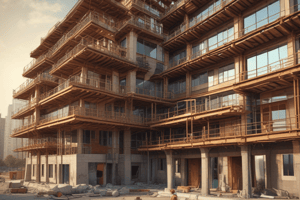Podcast
Questions and Answers
What is the expected cost range if the effort and definition are at the low end?
What is the expected cost range if the effort and definition are at the low end?
- $3.00 to $4.00 million
- $1.04 to $3.44 million (correct)
- $1.76 to $2.36 million
- $2.00 to $3.00 million
Which method provides the least accuracy in cost estimation?
Which method provides the least accuracy in cost estimation?
- Vendor quotes
- Using previous cost on similar equipment
- Cost estimating charts and scale for time (correct)
- Using detailed engineering data
What typical value of 'n' is used when applying the six-tenths rule for estimating cost increases?
What typical value of 'n' is used when applying the six-tenths rule for estimating cost increases?
- 0.4
- 0.6 (correct)
- 0.2
- 0.8
How much is the estimated percentage increase in cost when the capacity of a piece of equipment is doubled using the six-tenths rule?
How much is the estimated percentage increase in cost when the capacity of a piece of equipment is doubled using the six-tenths rule?
What is a significant caution when using previous costs on similar equipment for estimation?
What is a significant caution when using previous costs on similar equipment for estimation?
What does the symbol CFIT represent in project expenses?
What does the symbol CFIT represent in project expenses?
What percentage does Construction Overhead typically represent of the FCI?
What percentage does Construction Overhead typically represent of the FCI?
What symbolizes the fee associated with contractors on a project?
What symbolizes the fee associated with contractors on a project?
Which of the following is included in Auxiliary Facilities?
Which of the following is included in Auxiliary Facilities?
How much can the contingency factor cover in unforeseen expenses?
How much can the contingency factor cover in unforeseen expenses?
What does the symbol COff represent?
What does the symbol COff represent?
What percentage of the FCI do contractor engineering expenses typically represent?
What percentage of the FCI do contractor engineering expenses typically represent?
What does the symbol CAux refer to in project expenses?
What does the symbol CAux refer to in project expenses?
What is the formula used to calculate the cost of manufacturing (COM) with depreciation?
What is the formula used to calculate the cost of manufacturing (COM) with depreciation?
How is the number of operators per shift (NOL) calculated for different processing steps?
How is the number of operators per shift (NOL) calculated for different processing steps?
What adjustment should be made in the NOL calculation if there are more than 2 solids processing steps?
What adjustment should be made in the NOL calculation if there are more than 2 solids processing steps?
What is the calculated total salary cost of operating labor (COL) for the acetone facility?
What is the calculated total salary cost of operating labor (COL) for the acetone facility?
If the number of operating labor operators per shift is calculated as 4.5, what would be the total number of operators required?
If the number of operating labor operators per shift is calculated as 4.5, what would be the total number of operators required?
What was the estimated cost of the heat exchanger in 2001 using the Marshal and Swift Index?
What was the estimated cost of the heat exchanger in 2001 using the Marshal and Swift Index?
Using the Chemical Engineering Plant Cost Index, what was the estimated cost of the heat exchanger in 2001?
Using the Chemical Engineering Plant Cost Index, what was the estimated cost of the heat exchanger in 2001?
What is the value of K when using the formula $C = KA^n$ with the values provided?
What is the value of K when using the formula $C = KA^n$ with the values provided?
Using the six-tenths factor rule, how is the cost of a heat exchanger estimated for a larger area?
Using the six-tenths factor rule, how is the cost of a heat exchanger estimated for a larger area?
What is the formula used to estimate the capital cost of a plant with respect to capacity and inflation corrections?
What is the formula used to estimate the capital cost of a plant with respect to capacity and inflation corrections?
What is the projected cost index for the year 2013?
What is the projected cost index for the year 2013?
Calculate the average percentage difference between the two cost estimates for the heat exchanger in 2001.
Calculate the average percentage difference between the two cost estimates for the heat exchanger in 2001.
Which of the following represents direct project expenses?
Which of the following represents direct project expenses?
For the isopropanol plant, which year provided the original cost for calculating the cost in 2001?
For the isopropanol plant, which year provided the original cost for calculating the cost in 2001?
In the example provided for heat exchangers, which area corresponds to the higher cost?
In the example provided for heat exchangers, which area corresponds to the higher cost?
What does the term 'n' represent in the equation $C = KA^n$?
What does the term 'n' represent in the equation $C = KA^n$?
If the cost index in 2006 was 430.2 and in 2013 was 512.6, what does this indicate about the cost trends?
If the cost index in 2006 was 430.2 and in 2013 was 512.6, what does this indicate about the cost trends?
What is the cost correction factor used for adjusting costs from 30,000 metric tons/year to 50,000 metric tons/year?
What is the cost correction factor used for adjusting costs from 30,000 metric tons/year to 50,000 metric tons/year?
What inflation correction factor is used to estimate costs from 1986 to 2001 in the isopropanol plant example?
What inflation correction factor is used to estimate costs from 1986 to 2001 in the isopropanol plant example?
What is the estimated cost of a 50 m² heat exchanger in 2013, based on the details provided?
What is the estimated cost of a 50 m² heat exchanger in 2013, based on the details provided?
Which of the following is NOT considered a direct project expense?
Which of the following is NOT considered a direct project expense?
What is the capital cost for a major expansion to a fluid processing plant with a total purchased equipment cost of $6,800,000?
What is the capital cost for a major expansion to a fluid processing plant with a total purchased equipment cost of $6,800,000?
For a solid processing plant, what is the Lang factor (FLang)?
For a solid processing plant, what is the Lang factor (FLang)?
How is the Bare Module Factor (FBM) calculated?
How is the Bare Module Factor (FBM) calculated?
What factor represents the pressure adjustment for bare module cost calculations at 1 bar pressure?
What factor represents the pressure adjustment for bare module cost calculations at 1 bar pressure?
Which multiplier represents the materials of construction factor for bare module costs?
Which multiplier represents the materials of construction factor for bare module costs?
In the Bare Module Cost Factor formula, what does $α L$ represent?
In the Bare Module Cost Factor formula, what does $α L$ represent?
If the total purchased equipment cost is $10,000, what is the equipment's percentage of cost?
If the total purchased equipment cost is $10,000, what is the equipment's percentage of cost?
What is the Bare Module Cost ($CBM$) represented as?
What is the Bare Module Cost ($CBM$) represented as?
Flashcards
Cost Exponent (n)
Cost Exponent (n)
A mathematical exponent used to describe the relationship between the cost of equipment and its size or capacity. Typically ranges from 0.4 to 0.8, with 0.6 being a common value.
Economy of Scale
Economy of Scale
A principle describing how the cost of equipment increases as its capacity (size) increases. This increase is not proportional, but follows a power law where the exponent 'n' is typically between 0.4 and 0.8.
Six-Tenths Rule
Six-Tenths Rule
A rule of thumb stating that the cost of equipment increases by approximately 52% when its capacity is doubled, assuming a cost exponent of 0.6.
Effect of Capacity on Equipment Cost
Effect of Capacity on Equipment Cost
Signup and view all the flashcards
Scaling Up Equipment Cost
Scaling Up Equipment Cost
Signup and view all the flashcards
What is a Cost Index?
What is a Cost Index?
Signup and view all the flashcards
What is the Chemical Engineering Plant Cost Index (CEPCI)?
What is the Chemical Engineering Plant Cost Index (CEPCI)?
Signup and view all the flashcards
What is the Cost Exponent (n)?
What is the Cost Exponent (n)?
Signup and view all the flashcards
What is the Economy of Scale?
What is the Economy of Scale?
Signup and view all the flashcards
What is the Six-Tenths Rule?
What is the Six-Tenths Rule?
Signup and view all the flashcards
How do you Scale Up Equipment Cost?
How do you Scale Up Equipment Cost?
Signup and view all the flashcards
How does Capacity Affect Equipment Cost?
How does Capacity Affect Equipment Cost?
Signup and view all the flashcards
What is Inflation Correction?
What is Inflation Correction?
Signup and view all the flashcards
Cost index
Cost index
Signup and view all the flashcards
Six-tenths factor rule
Six-tenths factor rule
Signup and view all the flashcards
Equipment purchase cost
Equipment purchase cost
Signup and view all the flashcards
Direct project expenses
Direct project expenses
Signup and view all the flashcards
Indirect project expenses
Indirect project expenses
Signup and view all the flashcards
Contingency and fee
Contingency and fee
Signup and view all the flashcards
Auxiliary facilities
Auxiliary facilities
Signup and view all the flashcards
Total project cost
Total project cost
Signup and view all the flashcards
Cost of Raw Materials (CRM)
Cost of Raw Materials (CRM)
Signup and view all the flashcards
Manufacturing Cost Equation
Manufacturing Cost Equation
Signup and view all the flashcards
Number of Operators (NOL)
Number of Operators (NOL)
Signup and view all the flashcards
Cost of Operating Labor (COL)
Cost of Operating Labor (COL)
Signup and view all the flashcards
Operating Labor - Acetone Facility
Operating Labor - Acetone Facility
Signup and view all the flashcards
Bare Module Factor (FBM)
Bare Module Factor (FBM)
Signup and view all the flashcards
Module Factor Approach
Module Factor Approach
Signup and view all the flashcards
Bare Module Cost Factor (FBM)
Bare Module Cost Factor (FBM)
Signup and view all the flashcards
Purchased Equipment Cost (C)
Purchased Equipment Cost (C)
Signup and view all the flashcards
Pressure Factor (Fp)
Pressure Factor (Fp)
Signup and view all the flashcards
Material of Construction Factor (FM)
Material of Construction Factor (FM)
Signup and view all the flashcards
Total Module Cost (CTM)
Total Module Cost (CTM)
Signup and view all the flashcards
Bare Module Cost (CBM)
Bare Module Cost (CBM)
Signup and view all the flashcards
Freight, Insurance, and Taxes (CFIT)
Freight, Insurance, and Taxes (CFIT)
Signup and view all the flashcards
Construction Overhead (CO)
Construction Overhead (CO)
Signup and view all the flashcards
Contractor Engineering Expenses (CE)
Contractor Engineering Expenses (CE)
Signup and view all the flashcards
Contingency (CCont)
Contingency (CCont)
Signup and view all the flashcards
Contractor Fee (CFee)
Contractor Fee (CFee)
Signup and view all the flashcards
Site Development (CSite)
Site Development (CSite)
Signup and view all the flashcards
Auxiliary Buildings (CAux)
Auxiliary Buildings (CAux)
Signup and view all the flashcards
Off-sites and Utilities (COff)
Off-sites and Utilities (COff)
Signup and view all the flashcards
Study Notes
Cost Estimation
- Cost estimation is a crucial process in various fields, particularly in industrial plant projects.
- Capital investments are necessary before an industrial plant can operate.
- Fixed capital investment (FCI) covers the capital needed for manufacturing and plant facilities.
- Working capital (WC) involves capital required for plant operation.
- Total capital investment (TCI) combines FCI and WC.
Capital Investments
- FCI can be categorized into manufacturing and nonmanufacturing fixed-capital investment.
- Manufacturing FCI comprises capital for installed equipment and auxiliary systems (piping, instruments, etc.).
- Nonmanufacturing FCI deals with overhead for construction and plant components unrelated to the process (land, buildings, administrative offices, etc).
- The delivered cost is the total cost of equipment including transportation and installation.
Types of Capital Cost Estimates
- Order of Magnitude Estimate: Based on similar projects.
- Study Estimate: Using knowledge of major equipment.
- Preliminary Estimate: Sufficient data-based estimate.
- Definitive Estimate: Based on almost complete data.
- Detailed Estimate: Requires complete engineering drawings, specifications, and surveys.
Cost Estimation Methods
- Vendor quotations provide highly accurate cost estimates, based on technical specifications.
- Previous costs of similar equipment and time scale are also valid for reasonable estimations.
- Cost estimating charts offer an approach for cost estimations along with time scale for certain tasks.
Working Capital Investment
- Working capital is funds invested in raw materials, finished products, and accounts receivables.
- Raw materials inventory often represents a one-month supply.
- Finished products and semifinished goods inventory value approximately equals the total manufacturing cost of one month's production.
- Working capital ratio varies among companies, but ~10-20% of total capital investment is typical for chemical plants.
Effect of Capacity/Size
- The cost of equipment often scales with the power of 0.6 of capacity, often termed the 6/10 rule.
- Different equipment types exhibit different capacity-cost relationships (cost exponents).
- Typical values of cost exponents for various process equipment are available.
Effect of Time
- Cost indices account for changes in costs over time.
- Various cost indices are available for specific industries (e.g., Marshall & Swift, Engineering News-Record, Nelson-Farrar Refinery).
- The Chemical Engineering Plant Cost Index (CEPCI) is a significant index for chemical plant construction costs.
Economy of Scale
- The six-tenths rule provides a quick estimate of the percentage increase in cost when the capacity of a piece of equipment is doubled.
- The rule is generally applicable in estimating for process units and scale up.
Capital Cost Modules
- Total module cost (Lang factor) – A factor to multiply the purchase cost of the major equipment.
- Bare module cost – the cost of equipment in base conditions.
Cost of Operating Labor (COL)
- NOL equation helps estimate labor cost based on parameters like number of workers per shift and processing steps.
Studying That Suits You
Use AI to generate personalized quizzes and flashcards to suit your learning preferences.





